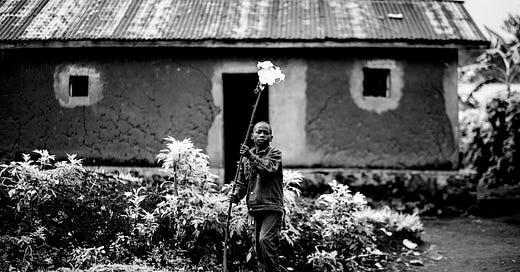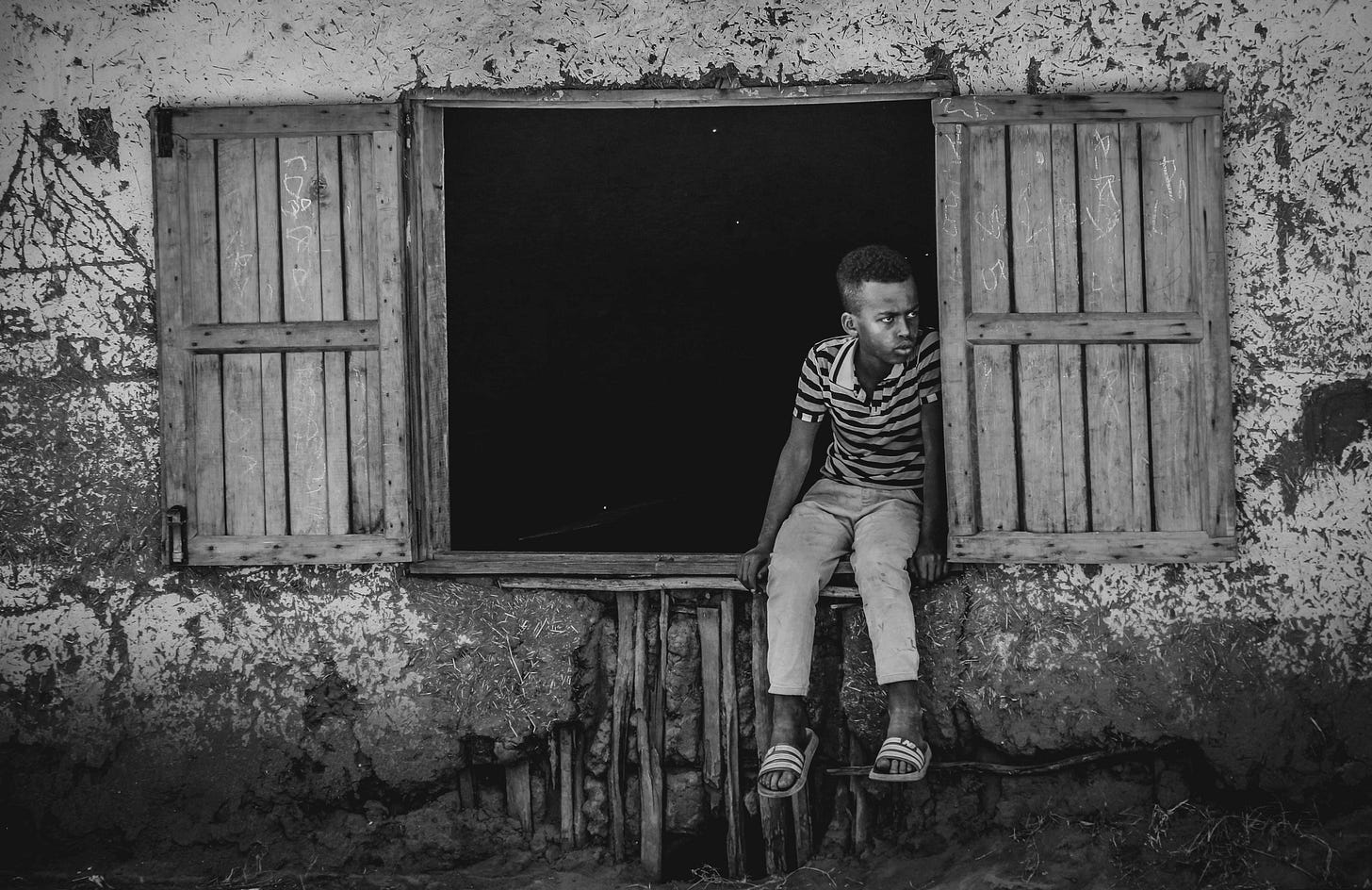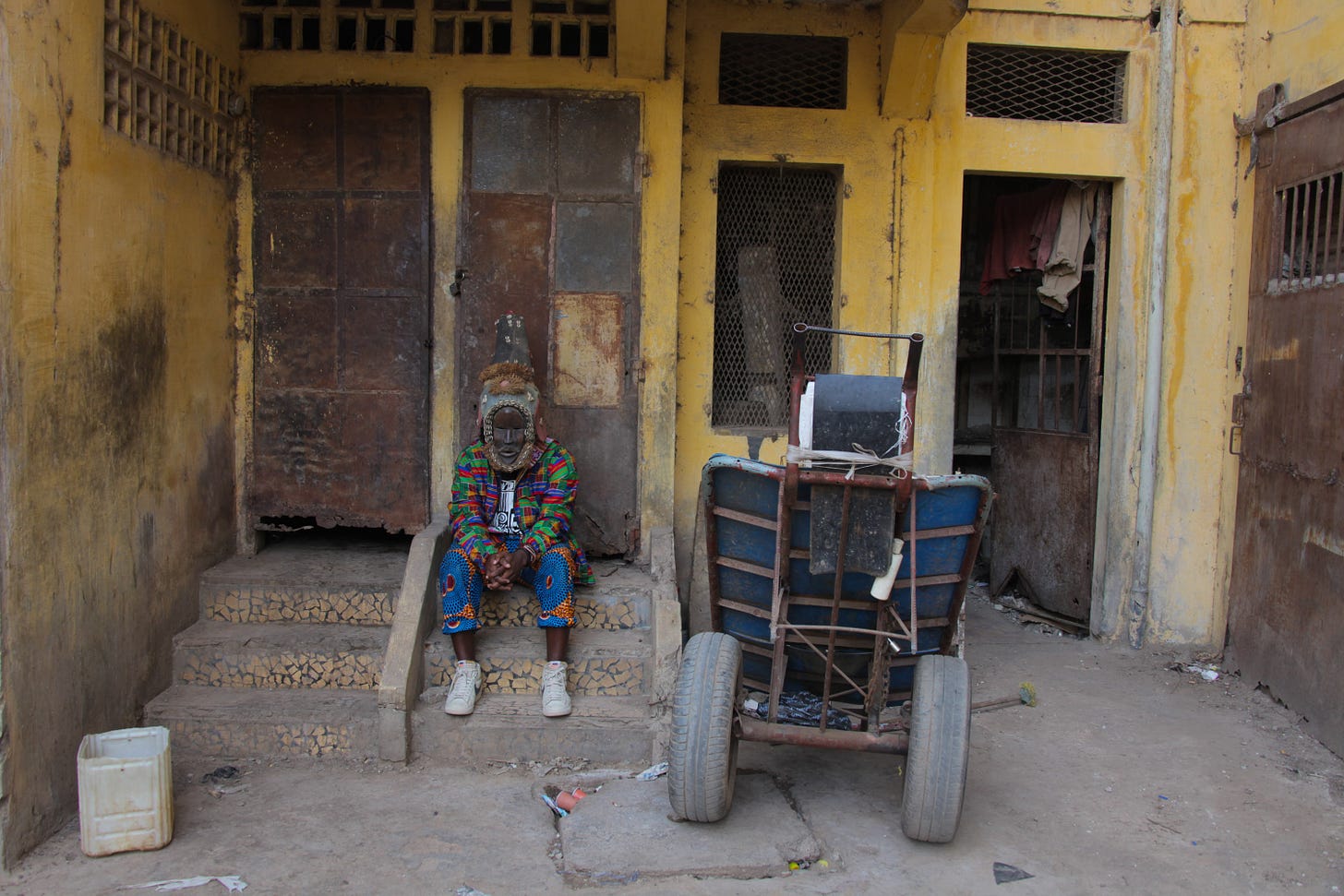This is the 170th edition of Tender Photo, a digital platform of African photography.
Contrasting monochrome hues dominate the photograph, from deep blacks to vibrant whites, interspersed with mid-tones. A rust-speckled, corrugated iron roof crowns a wall bearing deep, irregular fissures carved like accidental patterns. Two uneven black squares punctuate this facade, their edges unevenly plastered around into the cracks, the square on the right is larger on the second look. Between them, a vertical rectangle, deeply blackened, is noticeable and imposing. In the foreground, there are plants with leaves glowing brightly, sharply outlined against the surrounding dark tones. In the centre, a stoic boy with a petite body frame angles his left leg forward, and grips a slender, curved stick, topped with an irregularly shaped white object resembling the illuminated plants behind him.
—‘wùnmíbáyọ̀
“Photography is both a form of discovery and a tool for connection.”
Taken in 2018, this photograph is part of a documentary project, Au Quartier, which explores life in Rwandan neighborhoods. The project began in 2012 as a street photography project, capturing candid moments. It has since evolved to include interviews and personal stories, allowing me to engage directly with my subjects. I grew up in Nyamirambo, a bustling neighborhood in Kigali, observing the ingenuity of families in informal trade despite low incomes. This background has shaped my artistic perspective. My work reflects themes of identity, memory, womanhood, and mental health, celebrating the resilience of Rwandan daily life.
I chose this picture because it captures one of those rare, instinctive moments where everything comes together: the light, gesture, emotion, and meaning. In the photo, a young boy looks into the camera as he plants a wooden baton into the ground, a delicate white flower tied to its top. It was a small but deeply symbolic act that quietly indicates the sale of igipende, a traditional local drink, in that community. The moment felt intimate, honest, and perfectly timed. His gaze stayed with me. It felt like he was telling a story without needing words. Though I was born and raised in Rwanda, I continue to learn about my country every time I pick up my camera. Each community, each person I meet, reveals something new about survival, tradition, and how people adapt with quiet dignity. Kinigi was no exception.
As a self-taught photographer, I approach photography with curiosity and a willingness to learn daily. Photography has been both a form of discovery and a tool for connection. I constantly explore new techniques and strive to perfect the ones I’ve already acquired. It’s a growth journey, driven by reflection and the desire to tell meaningful stories.
— Alice Kayibanda
About Alice Kayibanda
Alice Kayibanda is a self-taught documentary photographer and writer based in Kigali, Rwanda. Her work explores the complexity of human experience, with a particular focus on womanhood, identity, memory, and resilience. Alice has a deep sensitivity for capturing people in their environments, using photography and narrative text to tell intimate, emotionally resonant stories. Her practice blends stark black-and-white or color images with evocative writing, uncovering the strength, vulnerability, and beauty found in everyday life—especially in the lives of women whose voices are often unheard.
RELATED — “An Open Window” by Minyahil Comander
I chose this photograph for its sheer power and the questions it evokes with regards to the everyday life of people. It is often said that the eyes of a person is a window to their mind. But how true is it really? In this photograph the space beyond the window is pitch dark, and whatever it harbours remains unknown. Sometimes the human mind is the same way. Looking at the little boy sitting on the window between the darkness of the room, and the visible outside, I began wondering what could be going on in his mind as he watched the girls. I could make a few guesses but like the darkness behind him, I can only guess, and not be certain about his thoughts. This makes the picture something to ponder on.
LAST WEEK — “The Mask” by Djibril Drame
A masked figure sits in stillness on the worn steps of a yellow façade, blending tradition and urban reality. Clad in vibrant wax prints and sneakers, they embody a quiet resilience amid the faded textures of everyday life. This portrait captures the tension between spiritual identity and working-class survival in contemporary Senegal.
TENDER PHOTO is a digital platform of African photography, founded by Emmanuel Iduma. This edition is edited by Adéwùnmí Adébáyọ̀, one of our editorial fellows. Our newsletter aims to engage with life on the African continent through photography. We publish narratives about the people, places, and events pictured in photographs, contributing to nuanced and layered perceptions. The newsletter also read on web (best for viewing images), and via the Substack iOS/Android apps.
Every Wednesday we feature a photograph, a short caption about it, and a statement from the photographer. In the past, we have published commentaries or photo-essays in response to photographs previously featured on the newsletter, including CORRESPONDENCES, CONCORDANCE, KINDRED, INDEX, and AFFINITIES.
Thank you for reading. If this newsletter was shared with you, consider subscribing, or forward to a friend. Please whitelist the newsletter to ensure you never miss it.









Top shot is beautiful -- and beautifully described...